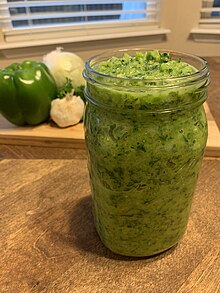 Epis Epis | |
| Alternative names | Epise, zepis |
|---|---|
| Type | Flavor base |
| Place of origin | Haiti |
| Main ingredients | Bell peppers, garlic, citrus juice, parsley, and other herbs and spices |
Epis (/ˈɛpiːs/, Haitian Creole: epis) is a blend of peppers, garlic, and herbs that is used as a flavor base for many foods in Haitian cuisine. Some refer to it as a pesto sauce. It is also known as epise and zepis. It is essential for Haitian cuisine.
Background
Epis has Taino and African origins. It also has similarities to sofrito which is used in Hispanic cuisine. This use of a flavor base is common in Caribbean cuisine.
Ingredients
Epis often contains parsley, scallions, garlic, citrus juice, and Scotch bonnet peppers. Numerous recipes for epis exist, as traditionally, Haitian women would cook and have their personal epis recipe. Also, various regions have different recipes.
Preparation
Traditionally, epis is made with a large wooden mortar and pestle (called munsh pilon). Today, it is often made with a blender. The ingredients are blended until the consistency is as smooth as desired.
Use
It can be used as a marinade for meat. It can also marinate fish. It also is added to flavor a number of Haitian dishes. This includes rice and beans, soups, and stews. It is a convenient way to utilize flavors from fresh herbs and spices in everyday cooking. Many Haitians have epis available on hand to be used for various dishes.
Dishes
Storage
Epis can last up to three months in the refrigerator, but this time will vary depending on the ingredients that are used. The acidity helps keep the ingredients from spoiling. Epis will last indefinitely in the freezer and will not transfer its odor to other freezer items. The epis can be distributed in an ice cube tray and frozen, so that the frozen cubes can be used in future cooking.
See also
References
- ^ "Haitian Epis". Haitian Cooking -. 2020-08-26. Retrieved 2021-04-11.
- ^ "Haitian epis". That Girl Cooks Healthy. 26 July 2019. Retrieved 2021-04-11.
- Louis-Jean, James; Sanon, Debbie; Louis-Jean, Kevin; Sanon, Nicole; Stvil Louis-Jean, Ruthonce; Thomas, Michelle Luvy (2021-04-09). "Valorization of pikliz: a spicy meal garnishment in Haitian cuisine". Journal of Ethnic Foods. 8 (1). Springer Science and Business Media LLC. doi:10.1186/s42779-021-00077-5. ISSN 2352-6181.
- ^ Long, L.M. (2015). Ethnic American Food Today: A Cultural Encyclopedia. Rowman & Littlefield Publishers. p. 257. ISBN 978-1-4422-2731-6. Retrieved 2021-04-11.
- ^ "Haitian Epis (Haitian Seasoning Base) Recipe". Savory Thoughts. 2019-01-07. Retrieved 2021-04-11.
- ^ "Epis (Haitian Seasoning Base)". Epicurious. 2016-12-19. Retrieved 2021-04-11.
- ^ Ménager, M.C. (2005). Fine Haitian Cuisine (in French). Educa Vision. p. 53. ISBN 978-1-58432-256-6. Retrieved 2021-04-11.
- ^ Charles, T.; Alcántara, J. (2021). Freedom Soup. Candlewick Press. p. 31. ISBN 978-1-5362-2165-7. Retrieved 2021-04-11.
- "Simple Haitian Epis". sidechef.com. 2021-01-18. Retrieved 2021-04-11.
| Cooking techniques | |||||||
|---|---|---|---|---|---|---|---|
| List of cooking techniques | |||||||
| Dry |
| ||||||
| Wet |
| ||||||
| Fat-based |
| ||||||
| Mixed medium | |||||||
| Device-based | |||||||
| Non-heat | |||||||
| See also | |||||||
| Meat | |||||
|---|---|---|---|---|---|
| Poultry |   | ||||
| Livestock | |||||
| Game | |||||
| Fish | |||||
| Shellfish and other seafood | |||||
| Insects | |||||
| Cuts and preparation |
| ||||
| List articles |
| ||||
| Ethics and psychology | |||||
| Alternatives | |||||
| Meat science | |||||
| Meat industry | |||||
| Related subjects | |||||